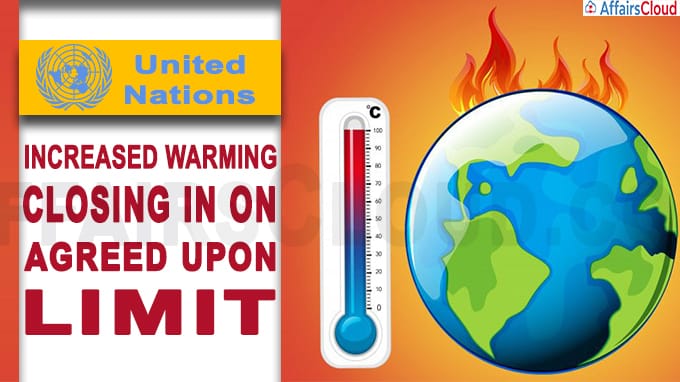 As per the United in Science 2020 report, the second in a series highlighted that the world is nearing to pass the temperature limit set by global leaders 5 years ago and may exceed it in the next decade or so. In the next 5 year, the world has about a 1-in-4 chance to experience a year that is hot enough to keep the global temperature at 2.7 degrees (1.5 °C-degrees Celsius) above pre-industrial times.
As per the United in Science 2020 report, the second in a series highlighted that the world is nearing to pass the temperature limit set by global leaders 5 years ago and may exceed it in the next decade or so. In the next 5 year, the world has about a 1-in-4 chance to experience a year that is hot enough to keep the global temperature at 2.7 degrees (1.5 °C-degrees Celsius) above pre-industrial times.
- 1.5°C is the more harsh of 2 limits set in 2015 by world leaders in the Paris climate change agreement.
- It is to be noted that the probability of 1.5 degrees (Celsius) is increasing year by year.
- Paris Agreement’s central aim is to strengthen the global response to the threat of climate change by keeping a global temperature rise this century well below 2 degrees Celsius above pre-industrial levels and to pursue efforts to limit the temperature increase even further to 1.5 degrees Celsius.
Points to be Noted
i.Excessive heat, record California wildfires and 2 two more Atlantic storms that set records for the earliest 16th and 17th named storms.
ii.Death Valley hit 130 degrees (54.4 degrees Celsius) and Siberia hit 100 degrees (38 degrees Celsius)earlier this year(2020).
Major Highlights of the report
i.The 5-year period from 2016–2020 is expected to be the warmest on record with an average global mean surface temperature of 1.1 °C(2 degrees) above pre-industrial era (1850–1900).
ii.It highlighted the wildfires in the Amazon, the Arctic and Australia. The heat waves and drought predominantly increased the risk of wildfires.
- In the last 4 years 3 largest economic losses were on record from wildfires.
iii.In 2020, there will be reduction by 4% to 7% in the Carbon dioxide emission, as there was minimal travel and industrial activities during the coronavirus pandemic.
iv.Total reduction in emissions in 2020 paves way to a small reduction in the annual increase of the atmospheric concentrations of long-lived greenhouse gases.
v.Global fossil CO2 emissions has reached 36.7 Gigatonnes (Gt) in 2019, which is considered as the new high record, 62% higher than in 1990.
Note– As per the 2018 UN science report, a world hotter than that still survives, but the risk of serious problems is greatly increased.
Additional Info
- There is both man-made warming and natural warming from a strong El Nino weather pattern in the past five years
- Some countries like the US and many in Europe are minimising the emission of heat-trapping carbon dioxide.
- The world is expected to reach 5.4 degrees (3 degrees Celsius) warmer compared with the late 19th century.
About the Report
The report is a multi-organization high-level compilation of the latest climate science information.
It has been compiled by the World Meteorological Organization (WMO) , with input from the Global Carbon Project, UNESCO Intergovernmental Oceanographic Commission (UNESCO-IOC), Intergovernmental Panel on Climate Change (IPCC), UN Environment Programme (UNEP) and the Met Office.
Recent Related News:
The Cooling Emissions and Policy Synthesis Report from the United Nations Environment Programme (UNEP) and the International Energy Agency (IEA) states that
By combining energy efficiency improvements with the transition away from super-polluting refrigerants, the world can avoid cumulative greenhouse gas emissions of between 210- 460 gigatonnes of carbon dioxide equivalent(GtCO2e) over the next four decades. This equals 4-8 years(roughly) of total annual global greenhouse gas emissions, based on 2018 levels.
About UN Environment Programme(UNEP):
Executive Director– Inger Andersen
Headquarters– Nairobi, Kenya




